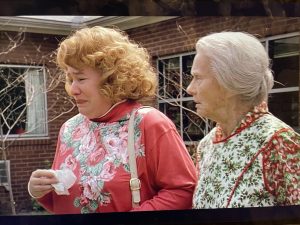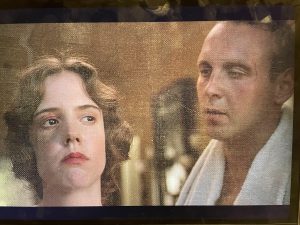The 1991 film, Fried Green Tomatoes, follows the journey of Evelyn Couch, an unhappy housewife living in 1980’s Birmingham, Alabama who finds motivation to better herself and her life through an old woman she meets in a local nursing home. This woman is Ninny Threadgoode, a very old woman who meets Evelyn and begins telling her stories of her sister-in-law Idgie Threadgoode and Idgie’s best friend, Ruth Jamison. Ninny describes Idgie and Ruth’s relationship through many stages of life- from when they were children, through Ruth’s troubling and abusive marriage and pregnancy, and their shared ownership of a local cafe in town until Ruth’s death later in the film. Although Evelyn had never met Idgie and Ruth, who had lived almost sixty years prior to when Evelyn first heard of them, Evelyn applies the lessons she learns from Idgie and Ruth to her own life as a way to become the person she has always aspired to be.

At the beginning of the film, Evelyn is undoubtedly a housewife whose daily routine consists of cleaning an already cleaned house, grocery shopping, and cooking dinner for her husband, Ed by the time he comes home from work. She is unhappy with her marriage because her husband does not appreciate her as a person and only ever talks to her about the food she cooks for him, and when Evelyn tries to change their monotonous routine, he criticizes her and calls her crazy. Evelyn was struggling immensely with her self esteem as a result of this mistreatment, and she could not seem to find a way out of it until she met Ninny. Ninny was a glimmer of hope for Evelyn’s life, and through the many stories Evelyn heard of Idgie and Ruth’s feminine independence and success in the old south, Evelyn became motivated to change her life for the better and focus on her own needs rather than her husband’s. By the end of the film, Evelyn’s daily routine includes regularly going to the gym, eating healthier food, cooking healthier meals for her husband that he hates and she knows it, and spending time for herself rather than putting all her worth

into her husband’s hands. Fried Green Tomatoes is a story of feminine empowerment and an example of women defying the odds and shattering societal expectations placed upon them in their rural, conservative southern hometowns.
When watching this film without the predisposition of studying the relations of food and society, a viewer may not even notice the role of food in this film because it is not emphasized at all. Rather, the relationship between food and this film is extremely subtle, but still has an immense impact on the overall plot and meaning of the film. Food appears in the film in a majority of scenes, but it is rarely depicted in detail or elaborated on, so the food in Fried Green Tomatoes, although it is seen in a majority of the film, takes on a more symbolic meaning than an explicit one. This role can be seen throughout the film in multiple scenes, in which, the food itself is only viewed and not even spoken of, but the presence of the food, the type of food present and the way it is eaten all conveys special messages and themes to the viewer about the film and the characters in it.
The film features the themes of taste & social order and cultural capital through the different foods that are seen being eaten by different characters in the film. Certain foods in the film had a cultural capital that signified higher social class and other foods signified lower social class. For example, the food featured at the wedding towards the beginning of the film was neatly prepared and presented and looked extremely decadent and expensive, which leads the viewer to associate the people eating those foods with a higher social class (8:30). On the other hand, the foods that Ruth and Idgie threw to people outside of the train looked like a completely different kind of food. It was packaged, canned, processed food that was available in abundance, and these people on the side of the train tracks were running along the tracks just to get some of it, like they were begging for this food (30:01). That signified a lower socioeconomic status and class because of how much they treasured these less extravagant foods, whereas the higher class people barely celebrated the food they had at all. Ruth’s character exemplifies this well. At the beginning of the film when she is about to fall into the normal social order and marry a man named Frank Bennett, the foods she has at her wedding are more expensive and rare for many people living in the south at this time. However, once Ruth leaves her husband and shatters social norms, her taste switches, and she surrounds herself with the food she makes at the Whistle Stop Cafe, which includes homemade pies, sausage and bacon, fried chick and fried green tomatoes, all of which are typically lower class, down home southern foods (50:43).
The southern foodway is radiated throughout this film. First of all, the title of the film is the name of one of the most obviously southern foods, fried green tomatoes. This is a delicacy in the American south and has been for many years. Along with the fried green tomatoes, the societal tradition and love for southern food in this film is evident, as the characters are seen eating typical southern foods at the Whistle Stop cafe, such as home baked pies, breakfast meats and eggs especially bacon, and a lot of coffee and beer (57:54). The down home southern hospitality way of

life is seen throughout the film through these foods and the way they are prepared. Another example of the southern foodway in this film is the barbecue Idgie has at the Whistle Stop Cafe the night after Frank Bennett was killed. This barbecue included typically southern barbecue- huge cuts of meat, steak and ribs, and tons of barbecue sauce (70:17). The final way this is seen is through the dishes Evelyn cooks for her husband at the beginning of the film, which include the most classically southern dish, fried chicken (19:52). Her husband actually compliments her fried chicken, but unfortunately, that is all he really has to say to her. Evelyn is a prime example of this foodway in the typical fashion in which is most relatable for viewers, especially older viewers who may have been in her same position before. Although Evelyn’s character is defined by her cooking at first, she also was a main proponent of a different theme in the film as well.
The theme of consumption as communication is represented in the film mostly with Evelyn’s character. Evelyn’s relationship with her husband is typical for the time period this movie was set- husband works and provides the monetary benefit while the wife stays home and cooks all the food for every meal. Her and her husband really only communicate at home over food when her husband comes home from work and takes his dinner into the living room to watch baseball. Evelyn asks if he will eat dinner with her at the table but he says no (19:49). This is consumption as communication because Evelyn and her husband often only communicate over their food. The only compliment I ever heard her husband say to her was that her fried chicken was delicious. In that way, they really only communicated over their consumption. Another way Evelyn’s character represents consumption as communication is her consumption of candy bars. She expresses that she eats 10 to 11 candy bars a day because they comfort her when she is feeling useless and worthless, but she is disappointed with herself for eating them because she knows they are bad for her (53:26).

Evelyn consuming so many candy bars is a form of communication to herself and to people around her that there is something wrong that she is trying to fix with these candy bars. Although candy bars are not the solution to her problem, they make her feel better momentarily so she continues to eat them. However, the communication of Evelyn’s consumption patterns change when she begins to make changes to her lifestyle and eats healthier foods instead of the typical southern foods (95:36). The form of communication in this example, therefore, depicts to the viewer that Evelyn is no longer the sad housewife who cannot do anything besides provide for her husband. Instead, she is capable of providing for herself like an independent woman.

Idgie and Ruth are proponents of feminine empowerment in the film just as Evelyn is. Their stories and backgrounds provide excellent examples of the theme of food and identity in this film. This theme is represented in the film mostly by gender roles and racism in the American south. The women in this film, during both time periods in which it is set, are regarded as property and lesser than men. As a result, they assume the typical gender roles prescribed for women in the American south- they are the cooks of the household, the cleaners, the caretakers of children, the babysitters, etc. and the men are the ones who have jobs and make most of the money. For example, Evelyn does not have a job and spends most of her day alone in the house cleaning or cooking and going to the grocery store (52:40). In the Whistle Stop Cafe, Ruth and Idgie are seen cooking and preparing meals for mostly male customers. Not only are these customers mostly male, they are all white as well (58:10). This introduces the theme of racism through food and identity in this film. The black cooks and workers at the cafe are asked to work in the back of the cafe, where customers cannot come in contact with them. Whenever they are seen, customers may get upset. For example, Grady said something to Idgie about making sure she “keeps those workers back in the back of the restaurant where no one can really see them” (58:06). Through this theme, we see how black Americans in the south were often asked to cook and prepare food for the people who were discriminating against them every single day.
The locational setting of Fried Green Tomatoes is Birmingham, Alabama, but it is set in two different time periods. The film switches back and forth between the 1930s and 1980s version of the southern town and its

daily lifestyle. In the 1930s, the film focuses on Idgie and Ruth and their hometown of Whistle Stop. During the 1930s flashbacks, the film progresses through Idgie and Ruth’s lives showing the beginning stages of their relationship when they were not so close, then how they became great friends over time and eventually best friends who owned the Whistle Stop Cafe together in town. Indicatively of this time period and place, Idgie and Ruth were both underestimated as women in every aspect of their lives. Idgie was often criticized for never marrying and people would judge her for never settling down, but due to her choices she was a symbol of feminine independence from men and societal expectations. Ruth was similar to Idgie in her symbol of independence but was more realistic for women during this time period. In the beginning, Ruth was definitely under the control of societal expectations. She married a man and took his name and bore a child with him, but he was abusive to her and physically and mentally mistreated her often. Instead of staying with him and remaining a victim of societal norms, Ruth packed her belongings, including her unborn child, and left her husband. The societal norms in the settings of this film are extremely important in determining the meaning and goal for the film in general.
After watching and analyzing this film, my informed opinion is that this film does a fascinating job at exemplifying women empowerment in a subtle and simple way. Just as the southern lifestyle often is, the film itself is extremely simplistic in nature, but the messages it conveys are powerful and hold great meaning in today’s society. This is one of the strengths of the film being that it was able to depict so much by only showing so little. Another strength of the film was its flashbacks between 1930s and 1980s Alabama because these two different images showed how the issue of sexism in America progressed through time, even after many political changes were made to give women more rights in the nation. For example, in the 1930s, Idgie and Ruth were expected to marry a man and settle down according to societal norms. Although Ruth did so, Idgie and Ruth ended up not living that life at all, and even owned a business together which was completely unlike what women did at the time (58:05). In the 1980s, societal expectations were seen and met in Evelyn’s case, in which, her daily routine was cooking, cleaning, and waiting for her husband to come home from work so she could fix him dinner (19:50). This historical representation of women’s rights was counteracted by the characters’ actions, showing the audience that women are empowered not by the rights they are given but by their will to become the people they want to be. A weakness of the film was that it ended in an odd way, with Ruth dying and the audience not knowing what happens to Ninny when she sees her house was torn down. It leaves the audience with many questions on where the characters end up, but the film itself was still successful in its purpose of displaying female empowerment and independence from societal expectations.
References
Avnet, J. & Jordan Kerner (Producers) & Avnet, J. (Director). (1991). Fried Green Tomatoes [Motion Picture]. United States: Act III Communications.